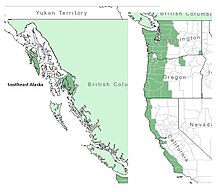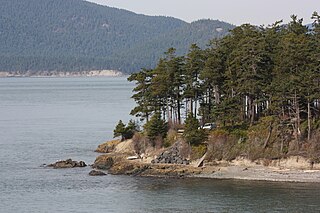
The Douglas fir is an evergreen conifer species in the pine family, Pinaceae. It is native to western North America and is also known as Douglas-fir, Douglas spruce, Oregon pine, and Columbian pine. There are three varieties: coast Douglas-fir, Rocky Mountain Douglas-fir and Mexican Douglas-fir.

Devil's club or Devil's walking stick is a large understory shrub native to the rainforests of the Pacific Northwest, but also disjunct on islands in Lake Superior. It is noted for its large palmate leaves and erect, woody stems covered in noxious and irritating spines. It is also known as Alaskan ginseng and similar names, although it is not a true ginseng.

Alnus rubra, the red alder, is a deciduous broadleaf tree native to western North America.

Thuja plicata is a large evergreen coniferous tree in the family Cupressaceae, native to the Pacific Northwest of North America. Its common name is western redcedar in the U.S. or western red cedar in the UK, and it is also called pacific red cedar, giant arborvitae, western arborvitae, just cedar, giant cedar, or shinglewood. It is not a true cedar of the genus Cedrus. T. plicata is the largest species in the genus Thuja, growing up to 70 metres (230 ft) tall and 7 m (23 ft) in diameter. It mostly grows in areas that experience a mild climate with plentiful rainfall, although it is sometimes present in drier areas on sites where water is available year-round, such as wet valley bottoms and mountain streamsides. The species is shade-tolerant and able to establish in forest understories and is thus considered a climax species. It is a very long-lived tree, with some specimens reaching ages of well over 1,000 years.
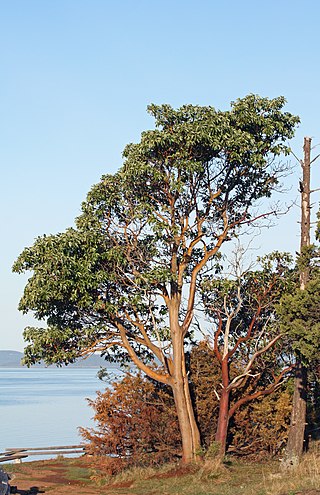
Arbutus menziesii or Pacific madrone, is a species of broadleaf evergreen tree in the family Ericaceae. It has waxy foliage, a contorted growth habit, and flaky bark.

Toxicodendron diversilobum, commonly named Pacific poison oak or western poison oak, is a woody vine or shrub in the sumac family, Anacardiaceae. It is widely distributed in western North America, inhabiting conifer and mixed broadleaf forests, woodlands, grasslands, and chaparral biomes. Peak flowering occurs in May. Like other members of the genus Toxicodendron, T. diversilobum causes itching and allergic rashes in most people after contact by touch or smoke inhalation. Despite its name, it is not closely related to oaks, nor is it a true tree.
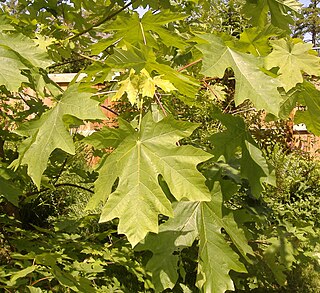
Acer macrophyllum, the bigleaf maple or Oregon maple, is a large deciduous tree in the genus Acer. It is native to western North America. In addition to uses by animals, it is of some culinary and woodworking interest.
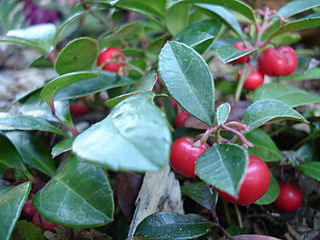
Gaultheria procumbens, also called the eastern teaberry, the checkerberry, the boxberry, or the American wintergreen, is a species of Gaultheria native to northeastern North America from Newfoundland west to southeastern Manitoba, and south to Alabama. It is a member of the Ericaceae.

Corylus cornuta, the beaked hazelnut, is a deciduous shrubby hazel with two subspecies found throughout most of North America.

Spiraea douglasii is a species of flowering plant in the rose family native to western North America. Common names include hardhack,hardhack steeplebush, Douglas' spirea, douglasspirea, steeplebush, and rose spirea.

The Northern California coastal forests are a temperate coniferous forests ecoregion of coastal Northern California and southwestern Oregon.
Northern coastal scrub is a scrubland plant community of California and Oregon. It occurs along the Pacific Coast from Point Sur on the Central California coast in Monterey County, California, to southern Oregon. It frequently forms a landscape mosaic with coastal prairie.

California mixed evergreen forest is a plant community found in the mountain ranges of California and southwestern Oregon.
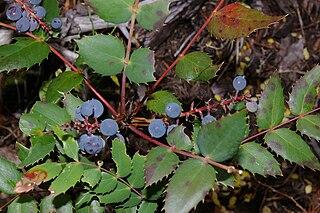
Berberis nervosa, commonly known as dwarf Oregon-grape, Cascade barberry, Cascade Oregon-grape, or dull Oregon-grape, is a flowering plant native to the northwest coast of North America from southern British Columbia south to central California, with an isolated population inland in northern Idaho. It is especially common in second growth, Douglas-fir or western redcedar forests, making use of those pools of sunlight that intermittently reach the ground.

Berberis repens commonly known as creeping mahonia, creeping grape holly, or creeping barberry, is a species of Berberis native to most of the western United States and two western provinces of Canada. It is low growing shrub that spreads by underground stems. As a species it is well adapted to fire and is a very common understory plant in western forests. An evergreen species, it provides food to deer and elk in winter and can make up a significant part of their diet. The berries are eaten by birds and small mammals, aiding it in spreading to recently disturbed areas. It has found use as a xeric ornamental plant and has escaped from cultivation in areas beyond its native range.

Townsend's chipmunk is a species of rodent in the squirrel family, Sciuridae. It lives in the forests of the Pacific Northwest of North America, from extreme southwestern British Columbia through western Washington and western Oregon. Townsend's chipmunk is named after John Kirk Townsend, an early 19th-century ornithologist.

Achlys is a small genus of flowering plants in the barberry family (Berberidaceae), which it shares with genera such as Berberis and Vancouveria. It is named after the Greek legendary figure associated with shade and mist, Achlys, because the plants grow in the shade.

The Klamath Mountains ecoregion of Oregon and California lies inland and north of the Coast Range ecoregion, extending from the Umpqua River in the north to the Sacramento Valley in the south. It encompasses the highly dissected ridges, foothills, and valleys of the Klamath and Siskiyou Mountains. It corresponds to the Level III ecoregion designated by the Environmental Protection Agency and to the Klamath-Siskiyou forests ecoregion designated by the World Wide Fund for Nature.
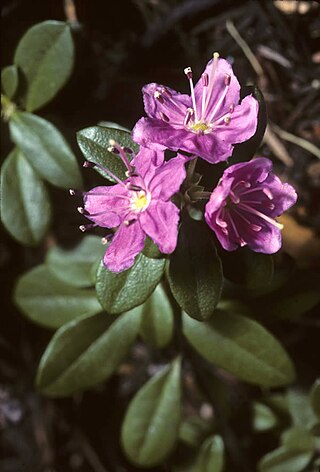
Kalmiopsis fragrans is a rare species of flowering plant in the heath family known by the common name North Umpqua kalmiopsis. It is endemic to Oregon in the United States, where there are just a few known populations, all within Douglas County.

Pseudotsuga menziesii var. menziesii, commonly known as Coast Douglas-fir, Pacific Douglas-fir, Oregon pine, or Douglas spruce, is an evergreen conifer native to western North America from west-central British Columbia, Canada southward to central California, United States. In Oregon and Washington its range is continuous from the Cascades crest west to the Pacific Coast Ranges and Pacific Ocean. In California, it is found in the Klamath and California Coast Ranges as far south as the Santa Lucia Mountains with a small stand as far south as the Purisima Hills, Santa Barbara County. In the Sierra Nevada it ranges as far south as the Yosemite region. It occurs from near sea level along the coast to 1,800 metres (5,900 ft) in the California Mountains. Further inland, coast Douglas-fir is replaced by Rocky Mountain or interior Douglas-fir. Interior Douglas-fir intergrades with coast Douglas-fir in the Cascades of northern Washington and southern British Columbia.

